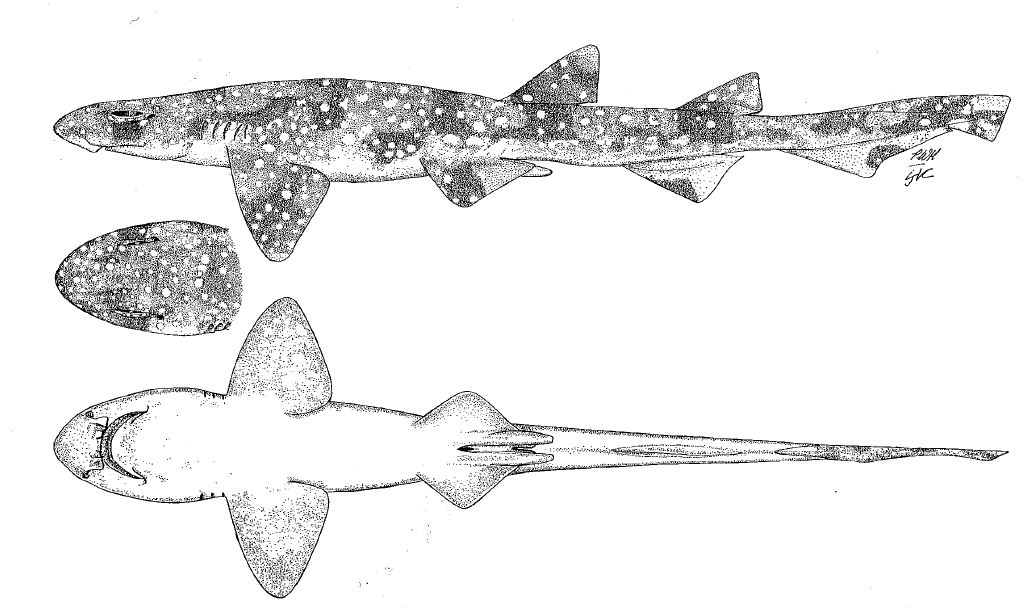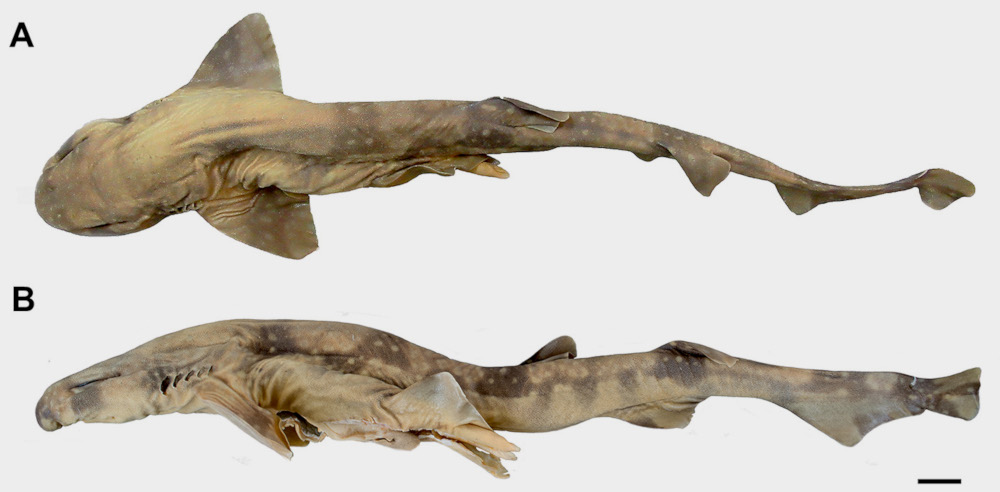Scyliorhinus comoroensis
Compagno, 1988
Comoro cat shark
Classification: Elasmobranchii Carcharhiniformes Scyliorhinidae
Reference of the original description
Scyliorhinus comoroensis sp. n., a new catshark from the Comoro Islands, western Indian Ocean (Carcharhiniformes, Scyliorhinidae). Bulletin du Muséum National d'Histoire Naturelle, (Série 4), Section A, Zoologie Biologie et Ecologie Animales, 10(3), 603–625
Scyliorhinus comoroensis sp. n., a new catshark from the Comoro Islands, western Indian Ocean (Carcharhiniformes, Scyliorhinidae). Bulletin du Muséum National d'Histoire Naturelle, (Série 4), Section A, Zoologie Biologie et Ecologie Animales, 10(3), 603–625
Image of the original description

Scyliorhinus comoroensis Compagno, 1988, MNHN 1984-771, holotype, 465 mm adult male, lateral and ventral

Scyliorhinus comoroensis Compagno, 1988, MNHN 1984-771, holotype, 465 mm adult male, lateral and ventral
Description :
Citation: Scyliorhinus comoroensis Compagno, 1988: In: Database of modern sharks, rays and chimaeras, www.shark-references.com, World Wide Web electronic publication, Version 11/2024
Please send your images of "Scyliorhinus comoroensis" to info@shark-references.com

Scyliorhinus comoroensis Compagno, 1988, MNHN 1984-771, holotype, 465 mm adult male, lateral and ventral © Karla A. Soares, Laboratório de Ictiologia, Departamento de Zoologia, Instituto de Biociências, Universidade de São Paulo

Scyliorhinus comoroensis Compagno, 1988, MNHN 1984-771, holotype, 465 mm adult male, lateral and ventral © Karla A. Soares, Laboratório de Ictiologia, Departamento de Zoologia, Instituto de Biociências, Universidade de São Paulo
Common names
 Comoro cat shark
Comoro cat shark
 Comoro cat shark
Comoro cat shark
Short Description
Diagnosis after Compagno, 1988 [3628]: A species of Scyliorhinus with a bluntly rounded, moderately long snout, preoral length 5.6 % of total length. Head moderately broad, greatest width 0.64 times of head length. Nostrils without nasoral grooves; anterior nasal flaps enlarged, reaching level of mouth but not touching each other at the midline, with a strong medial ridge. Tooth row counts 50/50. First dorsal origin just anterior to pelvic insertions; second dorsal origin over anal midbase; interdorsal space 0.9 times anal base. Denticles fairly large, teardrop-shaped, and barely tricuspidate, skin relatively rough. Inner margins of pelvic fins only partly fused into an apron over claspers, with a deep notch separating them for about half the inner margin length. Claspers long and slender, cylindrical and blunt-tipped, extending behind expanded free rear tips of pelvic fins but falling well anterior to anal origin. Clasper hooks absent, rhipidion welldeveloped, cover rhipidion weak, accessory terminal and ventral terminal 2 cartilages absent, dorsal terminal 2 present, dorsal and ventral terminal cartilages of equal length, end-style elongated and extending between terminal cartilages for about two-thirds of their lengths. Monospondylous precaudal vertebral count 40, total •vertebral count 137. Intestinal valve with 8 turns. Color pattern with bold, discrete dark gray-brown saddles and large blotches on a Iight-gray brown background, with scattered numerous small white spots size of eye pupil or slightly larger; white spots in saddles and spaces between them but not close-set; no small bold dark spots. Size small, male adult at 464 mm TL.
Diagnosis after Compagno, 1988 [3628]: A species of Scyliorhinus with a bluntly rounded, moderately long snout, preoral length 5.6 % of total length. Head moderately broad, greatest width 0.64 times of head length. Nostrils without nasoral grooves; anterior nasal flaps enlarged, reaching level of mouth but not touching each other at the midline, with a strong medial ridge. Tooth row counts 50/50. First dorsal origin just anterior to pelvic insertions; second dorsal origin over anal midbase; interdorsal space 0.9 times anal base. Denticles fairly large, teardrop-shaped, and barely tricuspidate, skin relatively rough. Inner margins of pelvic fins only partly fused into an apron over claspers, with a deep notch separating them for about half the inner margin length. Claspers long and slender, cylindrical and blunt-tipped, extending behind expanded free rear tips of pelvic fins but falling well anterior to anal origin. Clasper hooks absent, rhipidion welldeveloped, cover rhipidion weak, accessory terminal and ventral terminal 2 cartilages absent, dorsal terminal 2 present, dorsal and ventral terminal cartilages of equal length, end-style elongated and extending between terminal cartilages for about two-thirds of their lengths. Monospondylous precaudal vertebral count 40, total •vertebral count 137. Intestinal valve with 8 turns. Color pattern with bold, discrete dark gray-brown saddles and large blotches on a Iight-gray brown background, with scattered numerous small white spots size of eye pupil or slightly larger; white spots in saddles and spaces between them but not close-set; no small bold dark spots. Size small, male adult at 464 mm TL.
Distribution
Western Indian Ocean: Comoro Islands and northwestern coast of Madagascar (13º45’S, 47º38’E) [27296] Source: www.gbif.org
Western Indian Ocean: Comoro Islands and northwestern coast of Madagascar (13º45’S, 47º38’E) [27296] Source: www.gbif.org
Biology
Oviparous, paired eggs are laid. Embryos feed solely on yolk [733]. Attains 60 cm. Known only from Ngazidja in 40-400 m.
Oviparous, paired eggs are laid. Embryos feed solely on yolk [733]. Attains 60 cm. Known only from Ngazidja in 40-400 m.
Dentition
Monognathic heterodonty gradual well developed; anterior teeth abruptly larger than the parasymphysial ones and lateral teeth smaller distally, with smaller and thicker principal cusps. Sexual heterodonty not observed; only the holotype was examined. Tooth counts 25–25/21–22. Upper teeth with slightly higher principal cusps than lower ones, and striae longer and stouter. Parasymphysial and anterior teeth similar in shape and principal cusp straight; principal cusp flanked by one cusplet on each side. Lateral teeth with principal cusp slightly oblique and one cusplet on each side. Commissural teeth not examined. [27296]
Monognathic heterodonty gradual well developed; anterior teeth abruptly larger than the parasymphysial ones and lateral teeth smaller distally, with smaller and thicker principal cusps. Sexual heterodonty not observed; only the holotype was examined. Tooth counts 25–25/21–22. Upper teeth with slightly higher principal cusps than lower ones, and striae longer and stouter. Parasymphysial and anterior teeth similar in shape and principal cusp straight; principal cusp flanked by one cusplet on each side. Lateral teeth with principal cusp slightly oblique and one cusplet on each side. Commissural teeth not examined. [27296]
Remarks
shark-references Species-ID=6306;
shark-references Species-ID=6306;
















